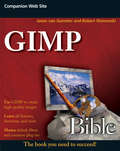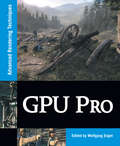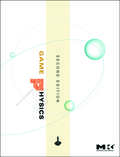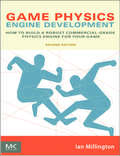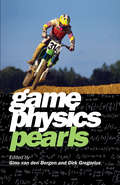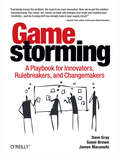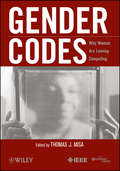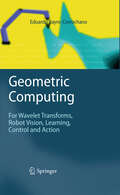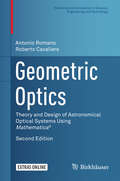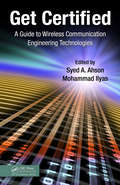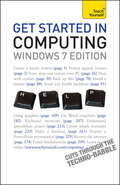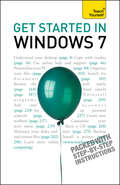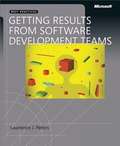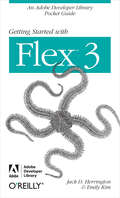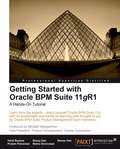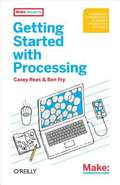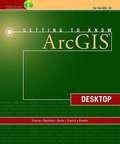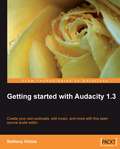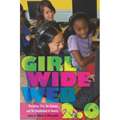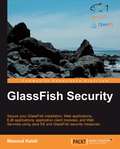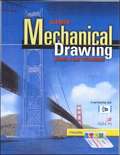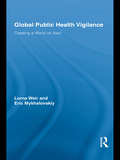- Table View
- List View
GIMP Bible
by Jason Van Gumster Robert ShimonskiThe ultimate reference and guide to the GNU image manipulation program GIMP is a free, Photoshop-like image manipulation program, and as its use grows, so does the demand for detailed instruction on how to get the very most out of it. GIMP Bible is the most comprehensive and current independent GIMP reference available that goes beyond official documentation. If you're a digital artist or photographer, the step-by-step explanations in this authoritative guide show you how to power-use GIMP throughout a production pipeline. Topics include understanding the GIMP interface and how to work with it, how to use all of GIMP's tools to create high-quality images, GIMP's default filters and plug-ins, advanced techniques for customization with Python and Scheme scripting, and much more. GIMP (GNU Image Manipulation Program) is a free graphics editor that runs on Linux, Windows, or Macs; it is used to process digital graphics and photographs including creating graphics and logos, resizing and cropping photos, altering colors, combining images, creating basic GIF animated images, and more Whether you're a digital artist, professional photographer, or beginner, this detailed how-to shows you best practices, valuable techniques, and helpful tips for getting the most out of GIMP for your projects Topics include the GIMP interface and how to work with it, in-depth description of GIMP's tools and how to use them to create high-quality images, a comprehensive reference for all of GIMP's default filters and common plug-ins, and advanced customization with Python and Scheme scripting Get the most out of this free image editing tool for your production pipeline with the GIMP Bible. Note: CD-ROM/DVD and other supplementary materials are not included as part of eBook file.
GPU Pro: Advanced Rendering Techniques
by Wolfgang EngelThis book covers essential tools and techniques for programming the graphics processing unit. Brought to you by Wolfgang Engel and the same team of editors who made the ShaderX series a success, this volume covers advanced rendering techniques, engine design, GPGPU techniques, related mathematical techniques, and game postmortems. A special emphasi
Game Physics
by David H. EberlyCreate physically realistic 3D Graphics environments with this introduction to the ideas and techniques behind the process. Author David H. Eberly includes simulations to introduce the key problems involved and then gradually reveals the mathematical and physical concepts needed to solve them.
Game Physics Engine Development: How to Build a Robust Commercial-Grade Physics Engine for your Game
by Ian MillingtonPhysics is really important to game programmers who need to know how to add physical realism to their games. They need to take into account the laws of physics when creating a simulation or game engine, particularly in 3D computer graphics, for the purpose of making the effects appear more real to the observer or player.The game engine ne
Game Physics Pearls
by Dirk Gregorius Gino van den BergenImplementing physical simulations for real-time games is a complex task that requires a solid understanding of a wide range of concepts from the fields of mathematics, physics, and software engineering. This book is a gems-like collection of practical articles in the area of game physics. Each provides hands-on detail that can be used in practical
Gamestorming: A Playbook for Innovators, Rulebreakers, and Changemakers (O'reilly Ser.)
by James Macanufo Sunni Brown Dave GrayGreat things don't happen in a vacuum. But creating an environment for creative thinking and innovation can be a daunting challenge. How can you make it happen at your company? The answer may surprise you: gamestorming.This book includes more than 80 games to help you break down barriers, communicate better, and generate new ideas, insights, and strategies. The authors have identified tools and techniques from some of the world's most innovative professionals, whose teams collaborate and make great things happen. This book is the result: a unique collection of games that encourage engagement and creativity while bringing more structure and clarity to the workplace. Find out why -- and how -- with Gamestorming.Overcome conflict and increase engagement with team-oriented gamesImprove collaboration and communication in cross-disciplinary teams with visual-thinking techniquesImprove understanding by role-playing customer and user experiencesGenerate better ideas and more of them, faster than ever beforeShorten meetings and make them more productiveSimulate and explore complex systems, interactions, and dynamicsIdentify a problem's root cause, and find the paths that point toward a solution
Ganzheitliches Life Cycle Management
by Christoph HerrmannWenn Unternehmen die Anforderungen einer nachhaltigen Entwicklung umsetzen, stehen sie vor der zentralen Aufgabe, Produkte und Prozesse lebensphasenübergreifend zu betrachten. Der Autor stellt die Gestaltungsmöglichkeiten des Life Cycle Managements vor und unterscheidet zwischen lebensphasenbezogenen Disziplinen wie z. B. dem Produkt- und Produktions-Management sowie lebensphasenübergreifenden Disziplinen (z. B. Informations- und Wissensmanagement). Zahlreiche Anwendungsbeispiele und Abbildungen dienen der Veranschaulichung der Inhalte.
Gender Codes: Why Women Are Leaving Computing
by Thomas J. MisaThe computing profession faces a serious gender crisis. Today, fewer women enter computing than anytime in the past 25 years. This book provides an unprecedented look at the history of women and men in computing, detailing how the computing profession emerged and matured, and how the field became male coded. Women's experiences working in offices, education, libraries, programming, and government are examined for clues on how and where women succeeded—and where they struggled. It also provides a unique international dimension with studies examining the U.S., Great Britain, Germany, Norway, and Greece. Scholars in history, gender/women's studies, and science and technology studies, as well as department chairs and hiring directors will find this volume illuminating.
Geometric Computing
by Eduardo Bayro-CorrochanoThis book offers a gentle introduction to Clifford geometric algebra, an advanced mathematical framework, for applications in perception action systems. Part I, is written in an accessible way allowing readers to easily grasp the mathematical system of Clifford algebra. Part II presents related topics. While Part 3 features practical applications for Computer Vision, Robotics, Image Processing and Neural Computing. Topics and Features include: theory and application of the quaternion Fourier and wavelet transforms, thorough discussion on geometric computing under uncertainty, an entire chapter devoted to the useful conformal geometric algebra, presents examples and hints for the use of public domain computer programs for geometric algebra. The modern framework for geometric computing highlighted will be of great use for communities working on image processing, computer vision, artificial intelligence, neural networks, neuroscience, robotics, control engineering, human and robot interfaces, haptics and humanoids.
Geometric Optics
by Antonio Romano Roberto CavaliereThis book--unique in the literature--provides readers with the mathematical background needed to design many of the optical combinations that are used in astronomical telescopes and cameras. The results presented in the work were obtained by using a different approach to third-order aberration theory as well as the extensive use of the software package Mathematica®. Replete with workout examples and exercises, Geometric Optics is an excellent reference for advanced graduate students, researchers, and practitioners in applied mathematics, engineering, astronomy, and astronomical optics. The work may be used as a supplementary textbook for graduate-level courses in astronomical optics, optical design, optical engineering, programming with Mathematica, or geometric optics.
Get Certified: A Guide to Wireless Communication Engineering Technologies
by Mohammad Ilyas Syed A. AhsonThe Institute of Electrical and Electronics Engineers (IEEE) Communications Society designed the IEEE wireless communication engineering technologies (WCET) certification program to address the wireless industry's growing need for communications professionals with practical problem-solving skills in real-world situations. Individuals who achieve th
Get Started In Computing: Teach Yourself
by Moira StephenGet Started in Computing is perfect for any new computer user who wants to get up and running quickly and simply. If you are a beginner it is a cost-effective alternative to buying an expensive manual for each application. Though Written for the general user, you will also find the level and content relevant if you are following MOUS certification, SQA modules and BCS Level 1/2 application courses.With step-by-step instructions, minimal jargon and detailed explanations of all the technical terms, this book will give you the confidence to move forward and expand your knowledge. Updated for Windows 7, the book covers all the basics, helping you to find ways of using your computer to suit you. Also included:- Health and safety laws and guidelines affecting the use of IT- Creating and maintaining a safe workstation environment- MS Office interface - ribbon, tabs, groups, MSO button and menu, Quick Access toolbar- Advantages and disadvantages of different email systems- Netiquette- Hidden dangers - unsolicited email, virus dangersNOT GOT MUCH TIME?One and five-minute introductions to key principles to get you started.AUTHOR INSIGHTSLots of instant help with common problems and quick tips for success, based on the author's many years of experience.TEST YOURSELFTests in the book and online to keep track of your progress.EXTEND YOUR KNOWLEDGEExtra online articles at www.teachyourself.com to give you a richer understanding of the basics of computing.FIVE THINGS TO REMEMBERQuick refreshers to help you remember the key facts.TRY THISInnovative exercises illustrate what you've learnt and how to use it.
Get Started In Computing: Teach Yourself (Ty Computing Ser.)
by Moira StephenGet Started in Computing is perfect for any new computer user who wants to get up and running quickly and simply. If you are a beginner it is a cost-effective alternative to buying an expensive manual for each application. Though Written for the general user, you will also find the level and content relevant if you are following MOUS certification, SQA modules and BCS Level 1/2 application courses.With step-by-step instructions, minimal jargon and detailed explanations of all the technical terms, this book will give you the confidence to move forward and expand your knowledge. Updated for Windows 7, the book covers all the basics, helping you to find ways of using your computer to suit you. Also included:- Health and safety laws and guidelines affecting the use of IT- Creating and maintaining a safe workstation environment- MS Office interface - ribbon, tabs, groups, MSO button and menu, Quick Access toolbar- Advantages and disadvantages of different email systems- Netiquette- Hidden dangers - unsolicited email, virus dangersNOT GOT MUCH TIME?One and five-minute introductions to key principles to get you started.AUTHOR INSIGHTSLots of instant help with common problems and quick tips for success, based on the author's many years of experience.TEST YOURSELFTests in the book and online to keep track of your progress.EXTEND YOUR KNOWLEDGEExtra online articles at www.teachyourself.com to give you a richer understanding of the basics of computing.FIVE THINGS TO REMEMBERQuick refreshers to help you remember the key facts.TRY THISInnovative exercises illustrate what you've learnt and how to use it.
Get Started in Windows 7: An absolute beginner's guide to the Windows 7 operating system
by Mac BrideGet Started in Windows 7 explains all the key aspects of this operating system from the user's angle including:- running programs and managing files- getting online- managing your email- maintaining your system- configuring printers- customising your system.- getting help- using accessoriesWritten for the new user at home or in the office it covers all the key features of Windows 7 and helps you maximise your use of the system with confidence.NOT GOT MUCH TIME?One and five-minute introductions to key principles to get you started.AUTHOR INSIGHTSLots of instant help with common problems and quick tips for success, based on the author's many years of experience.TEST YOURSELFTests in the book and online to keep track of your progress.EXTEND YOUR KNOWLEDGEExtra online articles at www.teachyourself.com to give you a richer understanding of Windows 7.FIVE THINGS TO REMEMBERQuick refreshers to help you remember the key facts.TRY THISInnovative exercises illustrate what you've learnt and how to use it.
Get Started in Windows 7: An absolute beginner's guide to the Windows 7 operating system
by Peter MacBrideGet Started in Windows 7 explains all the key aspects of this operating system from the user's angle including:- running programs and managing files- getting online- managing your email- maintaining your system- configuring printers- customising your system.- getting help- using accessoriesWritten for the new user at home or in the office it covers all the key features of Windows 7 and helps you maximise your use of the system with confidence.NOT GOT MUCH TIME?One and five-minute introductions to key principles to get you started.AUTHOR INSIGHTSLots of instant help with common problems and quick tips for success, based on the author's many years of experience.TEST YOURSELFTests in the book and online to keep track of your progress.EXTEND YOUR KNOWLEDGEExtra online articles at www.teachyourself.com to give you a richer understanding of Windows 7.FIVE THINGS TO REMEMBERQuick refreshers to help you remember the key facts.TRY THISInnovative exercises illustrate what you've learnt and how to use it.
Getting Results from Software Development Teams
by Lawrence J. PetersLearn best practices for software development project management--and lead your teams and projects to success. Dr. Lawrence Peters is an industry-recognized expert with decades of experience conducting research and leading real-world software projects. Beyond getting the best developers, equipment, budget, and timeline possible--Peters concludes that no factor is more critical to project success than the manager's role. Drawing on proven practices from allied industries such as business, psychology, accounting, and law, he describes a broader project-management methodology--with principles that software managers can readily adapt to help increase their own effectiveness and the productivity of their teams. Unlike other books on the topic, this book focuses squarely on the manager--and shows how to get results without adopting philosophies from Genghis Khan or Machiavelli. (There is mention of Godzilla, however.) Packed with real-world examples and pragmatic advice, this book shows any software development manager--new or experienced--how to lead teams in delivering the right results for their business.
Getting Started with Flex 3: An Adobe Developer Library Pocket Guide for Developers (Pocket Reference (O'Reilly))
by Jack D. Herrington Emily Kim Adobe Development TeamDiscover how easy RIA development can be with this one-of-a-kind handbook from the Adobe Developer Library. Several clear, step-by-step mini-tutorials teach you about web services, event handling, designing user interfaces with reusable components, and more. After finishing this guide, you'll be able to build Flash applications ranging from widgets to full-featured RIAs using the Flex SDK and Flex Builder 3.0. With Getting Started with Flex 3, you will:Walk through sample RIA projects and see examples of amazing applications people have built with FlexWork with ActionScript 3.0 and the MXML markup languageBuild user interfaces using the controls and tools available with the frameworkGet a tour of controls available commercially and through open sourceLearn how Flex integrates with ASP.NET, ColdFusion, PHP, and J2EE in the serverBuild Flex-based widgets that let you display real-time dataUse advanced controls to build 3D graphs, data dashboards, mapping applications, and moreYou'll find complete code for video players, a slideshow, a chat client, and an RSS reader, just to name a few. You also get plenty of tips, tricks, and techniques to leverage your existing programming skills, whether you come from an open source or Visual Studio-intensive background.
Getting Started with Oracle BPM Suite 11gR1 – A Hands-On Tutorial
by Heidi BuelowThis fully illustrated step-by-step tutorial is based on proven training content that has been highly praised by hundreds of developers in product training courses given as part of the BPM Suite 11g rollout. You will learn how to build a business process application project iteratively with each chapter introducing new technology components and adding a functional increment. Each chapter comes with a working solution for your reference. You can use the solution to start the tutorial at any point or to jump around to the chapters most interesting to you. This clear and detailed tutorial is perfect for both new and experienced business process developers, process architects, and process analysts looking for a pragmatic and hands-on approach to learning Oracle BPM Suite 11g.
Getting Started with Processing
by Ben Fry Casey ReasLearn computer programming the easy way with Processing, a simple language that lets you use code to create drawings, animation, and interactive graphics. Programming courses usually start with theory, but this book lets you jump right into creative and fun projects. It's ideal for anyone who wants to learn basic programming, and serves as a simple introduction to graphics for people with some programming skills. Written by the founders of Processing, this book takes you through the learning process one step at a time to help you grasp core programming concepts. You'll learn how to sketch with code -- creating a program with one a line of code, observing the result, and then adding to it. Join the thousands of hobbyists, students, and professionals who have discovered this free and educational community platform. Quickly learn programming basics, from variables to objects Understand the fundamentals of computer graphics Get acquainted with the Processing software development environment Create interactive graphics with easy-to-follow projects Use the Arduino open source prototyping platform to control your Processing graphics
Getting To Know ArcGIS Desktop
by Tim Ormsby Eileen J. Napoleon Robert Burke Carolyn Groessl Laura BowdenGetting to Know ArcGIS Desktop introduces principles of GIS as it teaches the mechanics of using ESRI's leading technology. Key concepts are combined with detailed illustrations and step-by-step exercises to acquaint readers with the building blocks of ArcGIS Desktop including ArcMap", for displaying and querying maps, ArcCatalog", for organizing geographic data, and Model Builder", for diagramming and processing solutions to complex spatial analysis problems. Its broad scope, simple style, and practical orientation make this book an ideal classroom text and an excellent resource for those learning GIS on their own. A data CD for working through the exercises and a fully functioning 180-day trial ArcGIS Desktop 10 software is included.
Getting started with Audacity 1.3
by Bethany HiitolaConversational and practical, this book is full of real life examples of where and how you would use the Audacity software. Not only does it give you task-based step-by-step instructions from installation to advanced audio editing techniques, it caters to the beginner to familiarize them with all the jargon, suggests recording equipment, it walks them through a simple sample project showing off everything Audacity can do. If you are new to audio recording and editing, and particularly using the Audacity software, this book is for you. It explains everything from common audio industry terms and software basics. Technical sound engineering details and jargon are omitted to keep the book friendly and easy to understand.
Girl Wide Web 2. 0: Revisiting Girls, The Internet, And The Negotiation Of Identity
by Sharon R. MazzarellaFrom social networking sites to game design, from blogs to game play, and from fan fiction to commercial web sites, Girl Wide Web 2.0 offers a complex portrait of millennial girls online. Grounded in an understanding of the ongoing evolution in computer and internet technology and in the ways in which girls themselves use that technology, the book privileges studies of girls as active producers of computer/internet content, and incorporates an international/intercultural perspective so as to extend our understanding of girls, the Internet, and the negotiation of identity.
GlassFish Security
by Masoud KalaliSecurity is driven by requirement and design and we implement security on the basis of the requirements provided by analysts. In this book, we take a programmatic approach to understand Java EE and GlassFish security. You will find plenty of code samples in this book. It is easy to secure your application when you have a demonstration of a complete and working application explained in the book, isn't it? Each chapter starts with the importance and relevance of the topic by introducing some Java EE applications requirement, which will encourage you to read it further. This book is for application designers, developers and administrators who work with GlassFish and are keen to understand Java EE and GlassFish security. To take full advantage of this book, you need to be familiar with Java EE and GlassFish application servers. You will love this book if you are looking for a book that covers Java EE security and using GlassFish features to create secure Java EE applications, or to secure the GlassFish installation and operating environment and using OpenSSO.
Glencoe Mechanical Drawing: Board and CAD Techniques
by Glencoe McGraw-Hill StaffProject-based learning prepares students for professional certification with Glencoe Mechanical Drawing: Board and CAD Techniques! Endorsed by the American Design Drafting Association (ADDA), this text includes Prep for ADDA activities. Step-by-step applications, design problems, and drafting problems prepare students for professional excellence and certification. Project-based learning is supported with unit-based projects that integrate technical math and culminate in Build Your Portfolio activities. Help your students get ready for competitive events like the TSA and SkillsUSA with prep activities embedded throughout the content and end-of-chapter assessments. Rigorous academic content is supported, with a special emphasis on math, geometry, and science, with STEM activities. Point-of-use correlations ease possible academic credit application. Extra activities in the Student Edition and workbook help you meet Perkins mandates. The appendix features Math (including algebra and geometry), abbreviations and symbols, pipe symbols, and reference tables (ASME, ANSI, ISO).
Global Public Health Vigilance: Creating a World on Alert (Routledge Studies in Science, Technology and Society)
by Lorna Weir Eric MykhalovskiyGlobal Public Health Vigilance is the first sociological book to investigate recent changes in how global public health authorities imagine and respond to international threats to human health. This book explores a remarkable period of conceptual innovation during which infectious disease, historically the focus of international disease control, was displaced by "international public health emergencies," a concept that brought new responsibilities to public health authorities, helping to shape a new project of global public health security. Drawing on research conducted at the World Health Organization, this book analyzes the formation of a new social apparatus, global public health vigilance, for detecting, responding to and containing international public health emergencies. Between 1995 and 2005 a new form of global health surveillance was invented, international communicable disease control was securitized, and international health law was fundamentally revised. This timely volume raises critical questions about the institutional effects of the concept of emerging infectious diseases, the role of the news media in global health surveillance, the impact of changes in international health law on public health reasoning and practice, and the reconstitution of the World Health Organization as a power beyond national sovereignty and global governance. It initiates a new research agenda for social science research on public health.
